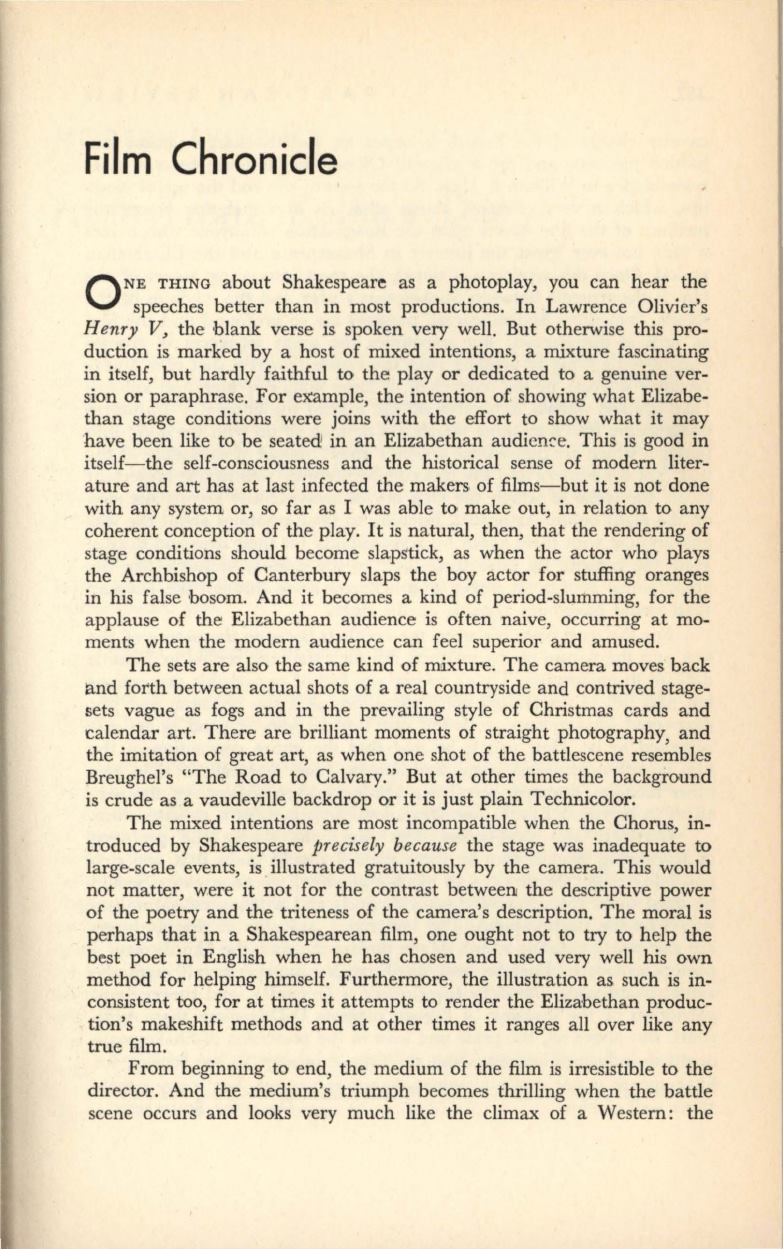
Film Chronicle
O
NE THING
about Shakespeare as a photoplay, you can hear the
speeches better than in most productions. In Lawrence Oli\rier's
Henry V,
the blank verse is spoken very well. But otherwise this pro–
duction is marked by a host of mixed intentions, a mixture fascinating
in itself, but hardly faithful to the play or dedicated to a genuine ver–
sion or paraphrase. For example, the intention of showing what Elizabe–
than stage conditions were joins with the effort to show what it may
have been like to be seated! in an Elizabethan audicn!:'e. This is good in
itself-the self-consciousness and the historical sense of modem liter–
ature and art has at last infected the makers of films-but it is not done
with any system or, so far as I was able to make out, in relation to any
coherent conception of the play. It is natural, then, that the rendering of
stage conditions should become slapstick, as when the actor who plays
the Archbishop of Canterbury slaps the boy actor for stuffing oranges
in his false bosom. And it becomes a kind of period-slumming, for the
applause of the Elizabethan audience is often naive, occurring at mo–
ments when the modern audience can feel superior and amused.
The sets are also the same kind of mixture. The camera moves back
and forth between actual shots of a real countryside and contrived stage–
sets vague as fogs and in the prevailing style of Christmas cards and
calendar art. There are brilliant moments of straight photography, and
the imitation of great art, as when one shot of the battlescene resembles
Breughel's "The Road to Calvary." But at other times the background
is crude as a vaude\rille backdrop or it is just plain Technicolor.
The mixed intentions are most incompatible when the Chorus, in–
troduced by Shakespeare
precisely because
the stage was inadequate to
large-scale events, is .illustrated gratuitously by the camera. This would
not matter, were it not for the contrast between the descriptive power
of the poetry and the triteness of the camera's description. The moral is
perhaps that in a Shakespearean film, one ought not to try to help the
best poet in English when he has chosen and used very well his own
method for helping himself. Furthermore, the illustration as such is in–
consistent too, for at times it attempts to render the Elizabethan produc–
tion's makeshift methods and at other times it ranges all over like any
true film.
From beginning to end, the medium of the film is irresistible to the
director. And the medium's triumph becomes thrilling when the battle
scene occurs and looks very much like the climax of a Western: the


